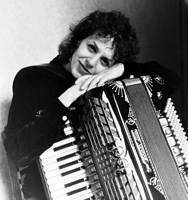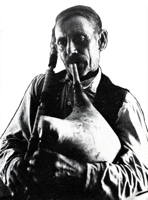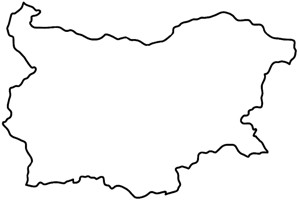
|
The Society of Folk Dance Historians (SFDH)
Instruments of Change in Bulgaria
[
Home |
About |
Encyclopedia | CLICK AN IMAGE TO ENLARGE |

|

 I once heard somebody say that where there are people still wearing costumes, that's where you'll find folk music that's alive and still thriving. Well, you won't find too many people walking around in costume in Bulgaria these days. Which doesn't mean that there's no folk music, but it does mean that the music has undergone a fundamental change as a result of the drastic change in the way of life. The day of the hand plow and the working bee are long gone, and village life as it was in Bulgaria is dying as people flock to the cities.
I once heard somebody say that where there are people still wearing costumes, that's where you'll find folk music that's alive and still thriving. Well, you won't find too many people walking around in costume in Bulgaria these days. Which doesn't mean that there's no folk music, but it does mean that the music has undergone a fundamental change as a result of the drastic change in the way of life. The day of the hand plow and the working bee are long gone, and village life as it was in Bulgaria is dying as people flock to the cities.
It must have been something in the old days, with no radio and no television. News was carried then by a singer who would often sit for hours in front of a totally enthralled audience and sing an epic song or a ballad with a tragic ending that would reduce the entire audience to tears, or he might sing about Ivan from the village two miles down the road who was involved in some sort of scandal. These were the old "maistori" who were famous for miles around for the way they could "tell" a story.
Music was an important and unifying force in the village community and music accompanied every important event in life literally from birth to death. There was no such thing as a holiday or a Sunday horo in the square without the village musicians out there in the middle playing away on their old instruments. There was no such thing in those days as a wedding that lasted longer than one day, generally speaking, and and a wedding without an accordion, clarinet, and maybe a violin just wasn't a wedding. So, how did things get this way?
The mass organizations of agriculture and the flight of the young people to the cities is one obvious answer. But it's only one part of the answer. There's also the founding of national ensembles of folk musicians and singers, the effects of which are still snowballing today. The organization of these ensembles was the culmination of a trend that began, as far as I can tell, back in the 1930s. This trend was one toward the combination of instruments into small "orchestras" with the purpose of playing "arranged music." As time passed, this "arranged music" became more and more complex and more and more foreign to the local musical traditions. A different type of professional musician came into existence, and with his coming there slowly developed an outlook toward the music that held that a harmonized melody is intrinsically better than the simple, unharmonized melody that had been the backbone of village music for centuries. So, the concept of "ensemble" was kicking around for almost twenty-five years before Philip Kutev founded the State Ensemble for Folk Songs and Dances in 1954.
It's hard to say what might have happened to Bulgarian folk music if the big ensembles had never come into existence, but with or without the ensembles the movement would still have been away from village music. The movement had to be away from the folk instruments because the function of musicians in the society had changed; their role was no longer sharply defined. Radio and television did away with the singer-news-bearers (who almost always accompanied themselves on an instrument, most often gadulka); the Sunday horo gradually disappeared, and scores of customs fell by the wayside for one reason or another. A great number of the young people who broke away from the village had no interest in the old instruments largely because they considered most things connected with the village to be "backward." Those who did learn to play an instrument chose accordion or clarinet more often than not.
Basically, what I want to say here, is that, for some of the reasons I've outlined and for some others I haven't, I have been forced to accept the fact that the dynamic force and the creative force in Bulgarian folk music today is the modern instrument and not the old folk instruments. Once again, I'm not saying that the old tradition and the old instruments are dead, but that they belong to a way of life that no longer exists. According to Raina Katsarova, music is a social manifestation, and this is a good case in point. The folk instruments are still around and there are still young people who are learning to play and sing. But it is no longer a mass phenomenon. I believe that songs and variants of songs, as well as melodies, will flourish with new and contemporary content but on a smaller scale.
The Bulgarian government, realizing the emergency nature of the situation, has attempted to re-educate the young people by setting up schools for folk instruments, the most famous and first one in Kotel, near Sliven, the second one in Shiroka Luka, near Smolyan in the Rhodopes, and a third in Sofia. The only problem is the lack of one ingredient, the crucial one: the conditions of life that give birth to the music and which keep it alive and vital.
The climate that gave acceptance to harmonized folk songs and melodies has probably paved the way toward the mass acceptance of modern instruments. It's my feeling that the accordion, clarinet, and violin must be accepted as a legitimate part of the folk music of Bulgaria because I think that it's precisely these instruments that will keep Bulgarian folk music alive for all of us to enjoy. I, myself, would like to see a situation where both modern and old can exist (or maybe I should say co-exist) and be respected as a legitimate expression of the Bulgarian spirit.
DOCUMENT
- Bulgaria, a country.
- Bulgarian Folk Music Instruments, an article.
- Bulgarian Village Music, an article.
- How to Build a Bulgarian or Macedonian Kaval, an article.
- How to Re-bag a Gajda, an article.
- How to Make a Large Macedonian Tapan, an article.
- Learn to Play Bulgarian and Macedonian Tambura, an article.
- Origin of the Folk Orchestra in Bulgaria, an article.
- Women Instrumentalists in Bulgaria, an article.
Used with permission of the
Center for Traditional Music and Dance Archive, www.ctmd.org.
Printed in Spring Folk Festival 1973.
This page © 2018 by Ron Houston.
Please do not copy any part of this page without including this copyright notice.
Please do not copy small portions out of context.
Please do not copy large portions without permission from Ron Houston.